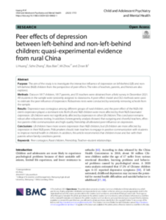Abstract:
Purpose
The aim of the study is to investigate the interactive influence of depression on left-behind (LB) and non-left-behind (NLB) children from the perspective of peer effects. The roles of teachers, parents, and friends are also explored.
Methods
Data on 1817 children, 1817 parents, and 55 teachers were obtained from a field survey in December 2021. All students in the sample were randomly assigned to classrooms. A peer effect model and OLS methods were used to estimate the peer influence of depression. Robustness tests were conducted by randomly removing schools from the sample.
Results
Depression was contagious among different groups of rural children, and the peer effect of the NLB children’s depression played a dominant role. Both LB and NLB children were more affected by their NLB classmates’ depression. LB children were not significantly affected by depression in other LB children. This conclusion remains robust after robustness testing. In addition, heterogeneity analysis showed that outgoing and cheerful teachers, effective parent–child communication and high-quality friendship all alleviated peer influence on depression.
Conclusions
LB children have more severe depression than NLB children, but LB children are more affected by depression in their NLB peers. Policymakers should train teachers to engage in positive communication with students to improve mental health in children. In addition, this article recommends that children move and live with their parents when family conditions permit.

